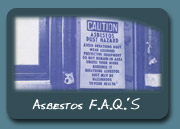
What is asbestos?“Asbestos” is the name given to a group of minerals that occur naturally
as bundles of fibers which can be separated into thin threads. These
fibers are not affected by heat or chemicals and do not conduct electricity.
For these reasons, asbestos has been widely used in many industries.
Four types of asbestos have been used commercially:
Asbestos fiber masses tend to break easily into a dust composed of tiny particles that can float in the air and stick to clothes. The fibers may be easily inhaled or swallowed and can cause serious health problems. Click here to return to the top of the page. How is asbestos used?Asbestos was mined and used commercially in North America beginning
in the late 1800s. Its use increased greatly during World War II.
Since then, it has been used in many industries. For example, the
building and construction industry has used it for strengthening cement
and plastics as well as for insulation, fireproofing, and sound absorption.
The shipbuilding industry has used asbestos to insulate boilers, steampipes,
and hot water pipes. The automotive industry uses asbestos in vehicle
brakeshoes and clutch pads. More than 5,000 products contain or have
contained asbestos. Some of them are listed below:
The regulations described above and other actions, coupled with widespread public concern about the hazards of asbestos, have resulted in a significant annual decline in U.S. use of asbestos: Domestic consumption of asbestos amounted to about 719,000 metric tons in 1973, but it had dropped to about 9,000 metric tons by 2002. Asbestos is currently used most frequently in gaskets and in roofing and friction products. Click here to return to the top of the page.
What are the health hazards of exposure to asbestos?Exposure to asbestos may increase the risk of several serious diseases:
Click here to return to the top of the page.
Who is at risk?Nearly everyone is exposed to asbestos at some time during their life. However, most people do not become ill from their exposure. People who become ill from asbestos are usually those who are exposed to it on a regular basis, most often in a job where they work directly with the material or through substantial environmental contact.
Although it is known that the risk to workers increases with heavier exposure and longer exposure time, investigators have found asbestos-related diseases in individuals with only brief exposures. Generally, those who develop asbestos-related diseases show no signs of illness for a long time after their first exposure. It can take from 10 to 40 years for symptoms of an asbestos-related condition to appear. There is some evidence that family members of workers heavily exposed to asbestos face an increased risk of developing mesothelioma. This risk is thought to result from exposure to asbestos fibers brought into the home on the shoes, clothing, skin, and hair of workers. This type of exposure is called paraoccupational exposure. To decrease these exposures, people exposed to asbestos at work are required to shower and change their clothing before leaving the workplace. Click here to return to the top of the page.
How great is the risk?Not all workers exposed to asbestos will develop diseases related to their exposure. The risk of developing asbestos-related diseases varies with the type of industry in which the exposure occurred and with the extent of the exposure. Asbestos that is bonded into finished products such as walls and tiles poses no risk to health as long as it is not damaged or disturbed (for example, by sawing or drilling) in such a way as to release fibers into the air. When asbestos fibers are set free and inhaled, however, exposed individuals are at risk of developing an asbestos-related disease. In addition, different types of asbestos fibers may be associated with different health risks. For example, results of several studies suggest that amphibole forms of asbestos may be more harmful than chrysotile, particularly for mesothelioma. Even so, no fiber type can be considered harmless, and people working with asbestos should always take proper safety precautions to limit exposure. Click here to return to the top of the page.
How does smoking affect risk?
There is evidence that quitting smoking will reduce the risk of lung cancer among asbestos-exposed workers. People who were exposed to asbestos on the job at any time during their life or who suspect they may have been exposed should not smoke. If they smoke, they should stop. Click here to return to the top of the page.
Who needs to be examined?Individuals who have been exposed (or suspect they have been exposed)
to asbestos fibers on the job or at home via a family contact should
inform their physician of their exposure history and any symptoms.
Asbestos fibers can be measured in urine, feces, mucus, or material
rinsed out of the lungs. A thorough physical examination, including
a chest x-ray and lung function tests, may be recommended. It is important
to note that chest x-rays cannot detect asbestos fibers in the lungs,
but they can help identify any lung changes resulting from asbestos
exposure. Interpretation of the chest x-ray may require the help of
a specialist who is experienced in reading x-rays for asbestos-related
diseases. Other tests also may be necessary. As noted earlier, the symptoms of asbestos-related diseases may not
become apparent for many decades after exposure. If any of the following
symptoms develop, a physical examination should be scheduled without
delay:
Click here to return to the top of the page.
How can workers protect themselves?Employers are required to follow regulations dealing with asbestos exposure on the job that have been issued by the Occupational Safety and Health Administration (OSHA), the Federal agency responsible for health and safety regulations in maritime, construction, manufacturing, and service workplaces. The Mine Safety and Health Administration (MSHA) enforces regulations related to mine safety. Workers should use all protective equipment provided by their employers and follow recommended work practices and safety procedures. For example, National Institute of Occupational Safety and Health (NIOSH)-approved respirators that fit properly should be worn by workers when required. Workers who are concerned about asbestos exposure in the workplace should discuss the situation with other employees, their employee health and safety representative, and their employers. If necessary, OSHA can provide more information or make an inspection. Regional offices of OSHA are listed in the “United States Government” section of telephone directories’ blue pages (under “Department of Labor”). The National Institute for Occupational Safety and Health (NIOSH) is another Federal agency that is concerned with asbestos exposure in the workplace. The Institute conducts asbestos-related research, evaluates work sites for possible health hazards, and makes exposure control recommendations. In addition, NIOSH distributes publications on the health effects of asbestos exposure and can suggest additional sources of information. Click here to return to the top of the page.
Will the Government provide examinations and treatment for asbestos-related conditions? What about insurance coverage?Medical services related to asbestos exposure are available through the Government for certain groups of eligible individuals. In general, individuals must pay for their own medical services unless they are covered by private or Government health insurance. Some people with symptoms of asbestos-related illness may be eligible for Medicare coverage. Information about benefits is available from the Medicare office serving each state. For the telephone number of the nearest office, call toll-free 1–800–633–4227 (1–800–MEDICARE). People with asbestos-related diseases also may qualify for financial help, including medical payments, under state workers’ compensation laws. Because eligibility requirements vary from state to state, workers should contact the workers’ compensation program in their state. Contact information for the workers’ compensation program in each state may be found in the blue pages of a local telephone directory. If exposure occurred during employment with a Federal agency (military or civilian), medical expenses and other compensation may be covered by the Federal Employees’ Compensation Program. Workers who are or were employed in a shipyard by a private employer may be covered under the Longshoremen and Harbor Workers’ Compensation Act. Workers also may wish to contact their international union for information on other sources of medical help and insurance matters. Eligible veterans and their dependents may receive health care at a Department of Veterans Affairs (VA) Medical Center. Treatment for service-connected and nonservice-connected conditions is provided. If the VA cannot provide the necessary medical care, they will arrange for enrolled veterans to receive care in their community. Information about eligibility and benefits is available from the VA Health Benefits Service Center at 1–877–222–8387 (1–877–222–VETS). Click here to return to the top of the page.
Is there a danger of nonoccupational exposure from the environment and products contaminated with asbestos fibers?
|
|||||||||
 Chrysotile
asbestos, with its curly fibers, is in the serpentine family of minerals.
The other types of asbestos, which all have rod-like fibers, are known
as amphiboles.
Chrysotile
asbestos, with its curly fibers, is in the serpentine family of minerals.
The other types of asbestos, which all have rod-like fibers, are known
as amphiboles.
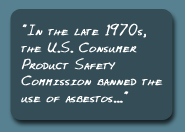 In
the late 1970s, the U.S. Consumer Product Safety Commission (CPSC)
banned the use of asbestos in wallboard patching compounds and gas
fireplaces because the asbestos fibers in these products could be
released into the environment during use. Additionally, asbestos was
voluntarily withdrawn by manufacturers of electric hair dryers. In
1989, the U.S. Environmental Protection Agency (EPA) banned all new
uses of asbestos; uses established prior to 1989 are still allowed.
The EPA has established regulations that require school systems to
inspect for damaged asbestos and to eliminate or reduce the exposure
to occupants by removing the asbestos or encasing it. In June 2000,
the CPSC concluded that the risk of children’s exposure to asbestos
fibers in crayons was extremely low. However, the U.S. manufacturers
of these crayons agreed to reformulate their products within a year.
In August 2000, the EPA recommended that consumers reduce possible
asbestos exposure from vermiculite-containing garden products by limiting
the amount of dust produced during use. The EPA suggested that consumers
use vermiculite outdoors or in a well-ventilated area; keep vermiculite
damp while using it; avoid bringing dust from vermiculite use into
the home on clothing; and use premixed potting soil, which is less
likely to generate dust.
In
the late 1970s, the U.S. Consumer Product Safety Commission (CPSC)
banned the use of asbestos in wallboard patching compounds and gas
fireplaces because the asbestos fibers in these products could be
released into the environment during use. Additionally, asbestos was
voluntarily withdrawn by manufacturers of electric hair dryers. In
1989, the U.S. Environmental Protection Agency (EPA) banned all new
uses of asbestos; uses established prior to 1989 are still allowed.
The EPA has established regulations that require school systems to
inspect for damaged asbestos and to eliminate or reduce the exposure
to occupants by removing the asbestos or encasing it. In June 2000,
the CPSC concluded that the risk of children’s exposure to asbestos
fibers in crayons was extremely low. However, the U.S. manufacturers
of these crayons agreed to reformulate their products within a year.
In August 2000, the EPA recommended that consumers reduce possible
asbestos exposure from vermiculite-containing garden products by limiting
the amount of dust produced during use. The EPA suggested that consumers
use vermiculite outdoors or in a well-ventilated area; keep vermiculite
damp while using it; avoid bringing dust from vermiculite use into
the home on clothing; and use premixed potting soil, which is less
likely to generate dust.
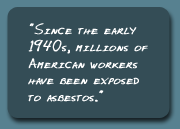 Since
the early 1940s, millions of American workers have been exposed to
asbestos. Health hazards from asbestos fibers have been recognized
in workers exposed in shipbuilding trades, asbestos mining and milling,
manufacturing of asbestos textiles and other asbestos products, insulation
work in the construction and building trades, brake repair, and a
variety of other trades. Demolition workers, drywall removers, and
firefighters also may be exposed to asbestos fibers. As a result of
Government regulations and improved work practices, today’s workers
(those without previous exposure) are likely to face smaller risks
than did those exposed in the past.
Since
the early 1940s, millions of American workers have been exposed to
asbestos. Health hazards from asbestos fibers have been recognized
in workers exposed in shipbuilding trades, asbestos mining and milling,
manufacturing of asbestos textiles and other asbestos products, insulation
work in the construction and building trades, brake repair, and a
variety of other trades. Demolition workers, drywall removers, and
firefighters also may be exposed to asbestos fibers. As a result of
Government regulations and improved work practices, today’s workers
(those without previous exposure) are likely to face smaller risks
than did those exposed in the past.
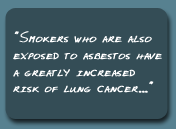 Many
studies have shown that the combination of smoking and asbestos exposure
is particularly hazardous. Smokers who are also exposed to asbestos
have a greatly increased risk of lung cancer. However,
smoking combined with asbestos exposure does not appear to increase
the risk of mesothelioma.
Many
studies have shown that the combination of smoking and asbestos exposure
is particularly hazardous. Smokers who are also exposed to asbestos
have a greatly increased risk of lung cancer. However,
smoking combined with asbestos exposure does not appear to increase
the risk of mesothelioma.
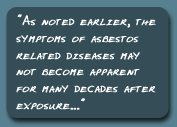
 Asbestos
is so widely used that the entire population has been exposed to some
degree. Air, drinking water, and a variety of consumer products all
may contain small amounts of asbestos. In addition, asbestos fibers
are released into the environment from natural deposits in the earth
and as a result of wear and deterioration of asbestos products. Disease
is unlikely to result from a single, high-level exposure, or from
a short period of exposure to lower levels of asbestos.
Asbestos
is so widely used that the entire population has been exposed to some
degree. Air, drinking water, and a variety of consumer products all
may contain small amounts of asbestos. In addition, asbestos fibers
are released into the environment from natural deposits in the earth
and as a result of wear and deterioration of asbestos products. Disease
is unlikely to result from a single, high-level exposure, or from
a short period of exposure to lower levels of asbestos.





